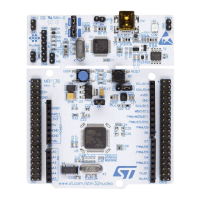UM1974 Rev 9 21/85
UM1974 Hardware layout and configuration
84
6.4.1 Power supply input from ST-LINK/V2-1 USB connector
The STM32 Nucleo-144 board and shield can be powered from the ST-LINK USB connector
CN1 (U5V), by placing a jumper between the pins 3 and 4 of JP3, as shown in
Table 8:
Power related jumper. Note that only the ST-LINK part is power supplied before the USB
enumeration, as the host PC only provides 100 mA to the board at that time. During the
USB enumeration, the STM32 Nucleo-144 board requires 300mA of current to the host PC.
If the host is able to provide the required power, the targeted STM32 microcontroller is
powered and the green LED LD6 is turned ON, thus the STM32 Nucleo-144 board and its
shield consume a maximum of 300
mA current, not more. If the host is not able to provide
the required current, the targeted STM32 microcontroller and the extension boards are not
power supplied. As a consequence the green LED LD6 stays turned OFF. In such case it is
mandatory to use an external power supply as explained in the next section.
After the USB enumeration succeeds, the ST-LINK U5V power is enabled, by asserting the
PWR_EN pin. This pin is connected to a power switch (ST890), which powers the board.
This power switch features also a current limitation to protect the PC in case of short-circuit
on board. If an overcurrent (more than 500
mA) happens on board, the red LED LD5 is lit.
JP1 is configured according to the maximum current consumption of the board when
powered by USB (U5V). JP1 jumper can be set to ON to inform the host PC that the
maximum current consumption does not exceed 100
mA (including potential extension
board or ST Zio shield). In such condition USB enumeration will always succeed, since no
more than 100
mA is requested to the PC. Possible configurations of JP1 are summarized
in
Table 6.
Caution: In case the maximum current consumption of the STM32 Nucleo-144 board and its shield
boards exceeds 300 mA, it is mandatory to power the STM32 Nucleo-144 board with an
external power supply connected to E5V, V
IN
or +3.3 V.
Note: In case the board is powered by a USB charger, there is no USB enumeration, so the green
LED LD6 stays in OFF state permanently and the target STM32 is not powered. In this
specific case the jumper JP1 must be set to ON, to allow the board to be powered anyway.
But in any case the current is limited to 500
mA by U4 (ST890).
6.4.2 External power supply inputs
The Nucleo-144 board and its shield boards can be powered in three different ways from an
external power supply, depending on the voltage used. The three power sources are
summarized in the
Table 7.
When STM32 Nucleo-144 board is power supplied by V
IN
or E5V, the jumper configuration
must be the following:
• Jumper JP3 on pin 1 and pin 2 for E5V or jumper JP3 on pin 5 and pin 6 for V
IN
• Jumper JP1 OFF
Table 6. JP1 configuration table
Jumper state Power supply Allowed current
JP1 jumper OFF
USB power through CN1
300 mA max
JP1 jumper ON 100 mA max
JP1 jumper (do not care) V
IN
, +3.3 V, +5 V power For current limitation refer to Table 8

